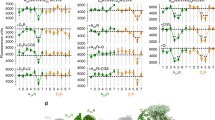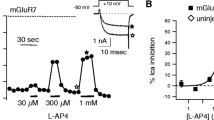Abstract
A1 adenosine receptors are in general coupled to inhibition of adenylyl cyclase, but have more recently been reported to be capable of also activating phospholipase C. The present study was done in order to investigate whether these different effects can be elicited by a single A1 receptor, or whether A1 receptor subtypes have to be invoked. The cDNA of a rat brain A1 adenosine receptor was stably expressed in CHO-cells, resulting in clones with varying receptor densities; a clone expressing 1.9 pmol receptors/mg membrane protein was used for further characterization. The ligand binding properties of the expressed receptors were typical for the rat A1 adenosine receptor. A1 receptor agonists caused a concentration-dependent inhibition of adenylyl cyclase activity in the membranes, with maximal inhibition by 70%. A1 receptor stimulation also caused concentration-dependent stimulation of inositol phosphate generation in these cells, with maximal effects of 300%. Both adenylyl cyclase inhibition and enhancement of inositol phosphate generation were essentially abolished after pretreatment of the cells with pertussis toxin. These results indicate that a single A1 adenosine receptor can couple to two effector pathways, and that both effectors are activated via pertussis toxin sensitive G proteins.
Similar content being viewed by others
Abbreviations
- CHA:
-
N6-cyclohexyladenosine
- CPA:
-
N6-cyclopentyladenosine
- DPCPX:
-
8-cyclopentyl-1,3-dipropylxanthine
- NECA:
-
5′-N-ethylcarboxamidoadenosine
- R-PIA:
-
R-N6-phenylisopropyladenosine
- IP1 :
-
inositol monophosphates
- IP2 :
-
inositol bisphosphates
- IP3 :
-
inositol trisphosphates
- PCR:
-
polymerase chain reaction
References
Alexander SPH, Hill SJ, Kendall DA (1990) Is the adenosine receptor modulation of histamine-induced accumulation of inositol phosphates in cerebral cortical slices mediated by effects on calcium fluxes? J Neurochem 55:1138–1141
Ali H, Cunha-Melo JR, Saul WF, Beaven MA (1990) Activation of phospholipase C via adenosine receptors provides synergistic signals for secretion in antigen-stimulated RBL-2H3 cells. J Biol Chem 265:745–753
Ashkenazi A, Winslow JW, Peralta EG, Peterson GL, Schimerlik MI, Capon J, Ramachandran J (1987) An m2 muscarinic receptor subtype coupled to both adenylyl cyclase and phosphoinositide turnover. Science 238:672–675
Belardinelli L, Isenberg G (1983) Isolated atrial myocytes: adenosine and acetylcholine increase potassium conductance. Am J Physiol 244:H734-H737
Birnbaumer L (1992) Receptor-to-effector signaling through G proteins: roles for βγ dimers as well as α subunits. Cell 71:1069–1072
Böhm M, Brückner R, Neumann J, Schmitz W, Scholz H, Starbatty J (1986) Role of guanine nucleotide-binding protein in the regulation by adenosine of cardiac potassium conductance and force of contraction. Evaluation with pertussis toxin. Naunyn-Schmiedeberg's Arch Pharmacol 332:403–405
Bradford MM (1976) A rapid and sensitive method for the quantitation of microgram quantities of protein utilizing the principle of protein-dye binding. Anal Biochem 72:248–254
Bruns RF, Fergus JH, Badger EW, Bristol JA, Santay LA, Hartman JD, Hays SJ, Huang CC (1987) Binding of the A1-selective antagonist' 8-cyclopentyl-1,3-dipropylxanthine to rat brain membranes. Naunyn-Schmiedeberg's Arch Pharmacol 335:59–63
Burnatowska-Hledin MA, Spielman WS (1991) Effects of adenosine on cAMP production and cytosolic Ca2+ in cultured rabbit medullary thick limb cells. Am J Physiol 260:C143-C150
Camps M, Carozzi A, Schnabel P, Scheer A, Parker P, Gierschik P (1992) Isozyme-selective stimulation of phospholipase C-β2 by G protein βγ-subunits. Nature 360:684–686
Cotecchia S, Kobilka BK, Daniel KW, Nolan RD, Lapetina EY, Caron MG, Lefkowitz RJ, Regan JW (1990) Multiple second messenger pathways of α-adrenergic receptor subtypes expressed in eukaryotic cells. J Biol Chem 265:63–69
Delahunty TM, Cronin MJ, Linden J (1988) Regulation of GH3-cell function via adenosine A1 receptors. Inhibition of prolactin release, cyclic AMP production and inositol phosphate generation. Biochem J 255:69–77
De Lean A, Hancock AA, Lefkowitz RJ (1982) Validation and statistical analysis of a computer modeling method for quantitative analysis of radioligand binding data for mixtures of pharmacological receptor subtypes. Mol Pharmacol 21:5–16
Dell'Acqua ML, Carroll RC, Peralta EG (1993) Transfected m2 muscarinic acetylcholine receptors couple to Gαi2 and Gαi3 in chinese hamster ovary cells. Activation and desensitization of the phospholipase C signaling pathway. J Biol Chem 268:5676–5685
De Mazancourt P, Giudicelli Y (1984) Guanine nucleotides and adenosine ‘Ri’-site analogues stimulate the membrane bound low-Km cyclic AMP phosphodiesterase of rat adipocytes. FEBS Lett 173: 385–388
Dolphin AC, Forda SR, Scott RH (1986) Calcium-dependent currents in cultured rat dorsal root ganglion neurones are inhibited by an adenosine analogue. J Physiol (Lond) 373:47–61
Fargin A, Raymond JR, Regan JW, Cotecchia S, Lefkowitz RJ, Caron MG (1989) Effector coupling mechanisms of the cloned 5-HT 1A receptor. J Biol Chem 264:14848–14852
Freissmuth M, Schütz W, Linder ME (1991) Interactions of the bovine brain A1-adenosine receptor with recombinant G protein α-subunits. J Biol Chem 266:17778–17783
Gerwins P, Fredholm BB (1992a) ATP and its metabolite adenosine act synergistically to mobilize intracellular calcium via the formation of inositol 1,4,5-trisphosphate in a smooth muscle cell line. J Biol Chem 267:16081–16087
Gerwins P, Fredholm BB (1992b) Stimulation of A1 adenosine receptors and bradykinin receptors, which act via different G proteins, synergistically raises inositol 1,4,5-trisphosphate and intracellular free calcium in DDT1 MF-2 smooth muscle cells. Proc Natl Acad Sci USA 89:7330–7334
Gerlach E, Becker BF (1987) Topics and perspectives in adenosine research. Springer, Berlin Heidelberg New York
Goodman RR, Cooper MJ, Gavish M, Snyder SH (1982) Guanine nucleotide and cation regulation of the binding of [3H]cyclohexyl-adenosine and [3H]diethylphenylxanthine to adenosine A1 receptors in brain membranes. Mol Pharmacol 21:329–335
Hollingsworth EB, De La Cruz RA, Daly JW (1986) Accumulations of inositol phosphates and cyclic AMP in brain slices: synergistic interactions of histamine and 2-chloroadenosine. Eur J Pharmacol 122:45–50
Jakobs KH, Saur W, Schultz G (1976) Reduction of adenylate cyclase activity in lysates of human platelets by the alpha-adrenergic component of epinephrine. J Cyclic Nucleotide Res 2:381–392
Katz A, Wu D, Simon MI (1992) Subunits βγ of heterotrimeric G protein activate β2 isoform of phospholipase C. Nature 360:686–689
Kelley GG, Poeschla EM, Barron HV, Forrest JN Jr (1990) A1 adenosine receptors inhibit chloride transport in the shark rectal gland. Dissociation of inhibition and cyclic AMP. J Clin Invest 85: 1629–1636
Klotz K-N, Cristalli G, Grifantini M, Vittori S, Lohse MJ (1985) Photoaffinity labeling of A1 adenosine receptors. J Biol Chem 260:14659–14664
Kohl C, Linck B, Schmitz W, Scholz H, Scholz J, Tóth M (1990) Effects of carbachol and (−)-N6-phenylisopropyladenosine on myocardial inositol content and force of contraction. Br J Pharmacol 101:829–834
Kurtz A (1987) Adenosine stimulates guanylate cyclase activity in vascular smooth muscle cells. J Biol Chem 262:6296–6300
Libert M, Schiffmann S, Lefort A, Parmentier M, Gerard C, Dumont J, Vanderhaeghen JJ, Vassart G (1991) The orphan receptor cDNA RDC7 encodes an A1 adenosine receptor. EMBO J 10:9677–1682
Linden J (1991) Structure and function of A1 adenosine receptors. FASEB J 5:2668–2676
Lohse MJ (1992) Stable overexpression of β2-adrenergic receptors in mammalian cells. Naunyn-Schmiedeberg's Arch Pharmacol 345: 444–451
Lohse MJ, Lenschow V, Schwabe U (1984) Two affinity states of Ri adenosine receptors in brain membranes: Analysis of guanine nucleotide and temperature effects on radioligand binding. Mol Pharmacol 26:1–9
Lohse MJ, Klotz K-N, Schwabe U (1986) Agonist photoaffinity labeling of A1 adenosine receptors: Persistent activation reveals spare receptors. Mol Pharmacol 30:403–409
Lohse MJ, Klotz K-N, Lindenborn-Fotinos J, Reddington M, Schwabe U, Olsson RA (1987a) 8-Cyclopentyl-1,3-dipropylxanthine (DPCPX) — a selective high affinity antagonist radioligand for A1 adenosine receptors. Naunyn-Schmiedeberg's Arch Pharmacol 336:204–210
Lohse MJ, Maurer K, Gensheimer H-P, Schwabe U (1987b) Dual actions of adenosine on rat peritoneal mast cells. Naunyn-Schmiedeberg's Arch Pharmacol 335:555–560
Lohse MJ, Klotz K-N, Schwabe U, Cristalli G, Vittori S, Grifantini M (1988a) Pharmacology and biochemistry of adenosine receptors. In: Melchiorre C Gianella M (eds) Recent advances in receptor biochemistry. Elsevier, Amsterdam, pp 107–121
Lohse MJ, Klotz K-N, Salzer MJ, Schwabe U (1988 b) Adenosine regulates the Ca++ sensitivity of mast cell mediator release. Proc Natl Acad Sci USA 85:8875–8879
Lohse MJ, Klotz K-N, Schwabe U (1991) Mechanism of activation of A2 adenosine receptors: I. Blockade of A2 adenosine receptors by photoaffinity labelling. Mol Pharmacol 39:517–523
Londos C, Cooper DMF, Wolff J (1980) Subclasses of external adenosine receptors. Proc Natl Acad Sci USA 77:2551–2554
Mahan LC, McVittie LD, Smyk-Randall EM, Nakata H, Monsma FJ, Gerfen CR, Sibley DR (1991) Cloning and Expression of an A1 adenosine receptor from rat brain. Mol Pharmacol 40:1–7
Okajima F, Sato K, Sho K, Kondo Y (1989) Stimulation of adenosine receptor enhances α1-adrenergic receptor-mediated activation of phospholipase C and Ca2+ mobilization in a pertussis toxin-sensitive manner in FRTL-5 thyroid cells. FEBS Lett 248:145–149
Ott I, Lohse MJ, Klotz K-N, Vogt-Moykopf I, Schwabe U (1992) Effects of adenosine on histamine release from human lung fragments. Int Arch Allergy Immunol 98:50–56
Park D, Jhon DY, Lee CW, Lee KH, Rhee SG (1993) Activation of phospholipase C isozymes by G protein βγ subunits. J Biol Chem 268:4573–4576
Peralta EG, Ashkenazi A, Winslow JW, Ramachandran J, Capon DJ (1988) Differential regulation of PI hydrolysis and adenylyl cyclase by muscarinic receptor subtypes. Nature 334:434–437
Puurunen J, Lohse MJ, Schwabe U (1987) Interactions between intracellular cyclic AMP and agonist-induced inositol phospholipid breakdown in isolated gastric mucosal cells of the rat. Naunyn-Schmiedeberg's Arch Pharmacol 336:471–477
Raymond JR, Albers FJ, Middleton JP (1992) Functional expression of human 5-HT1A receptors and differential coupling to second messengers in CHO cells. Naunyn-Schmiedeberg's Arch Pharmacol 346:127–137
Rugolo M, Mastrocola T, Whörle C, Rasola A, Gruenert DC, Romeo G, Galietta LJV (1993) ATP and A1 adenosine receptor agonists mobilize intracellular calcium and activate K+ and Cl− currents in normal and cystic fibrosis airway epithelial cells. J Biol Chem 268:24779–24784
Reppert SM, Weaver DR, Stehle JH, Rivkees SA (1991) Molecular cloning and characterization of a rat A1 adenosine receptor that is widely expressed in rat brain and spinal cord. Mol Endocrin 5:1037–1048
Schachter JB, Wolfe BB (1992) Cyclic AMP differentiates two separate but interacting pathways of phosphoinositide hydrolysis in the DDT1-MF2 smooth muscle cell line. Mol Pharmacol 41:587–597
Schwabe U (1985) Use of radioligands in the identification, classification, and study of adenosine receptors. In: Paton DM (ed.) Methods used in adenosine research. Methods in pharmacology, vol 6. Plenum Press, New York, pp 239–278
Smrcka AV, Sternweis PC (1993) Regulation of purified subtypes of phosphatidylinositol-specific phospholipase C β by G protein α and βγ subunits. J Biol Chem 268:9667–9674
Trussell LO, Jackson MB (1985) Adenosine-activated potassium conductance in cultured striatal neurons. Proc Natl Acad Sci USA 82:4857–4861
Ungerer M, Obermaier-Skrobranek B, Lohse MJ (1992) A1-adenosine receptor gene structure and regulation in normotensive and spontaneously hypertensive rats. Eur J Pharmacol Mol Pharmacol Sect 226:381–382
Vallar L, Muca C, Magni M, Albert P, Bunzow J, Meldolesi J, Civelli O (1990) Differential coupling of dopaminergic D2 receptors expressed in different cell types. J Biol Chem 265:10320–10326
Van Calker D, Müller N, Hamprecht B (1979) Adenosine regulates by two different receptors the accumulation of cyclic AMP in cultured brain cells. J Neurochem 33:999–1005
White TE, Dickinson JM, Alexander SP, Hill SJ (1992) Adenosine A1-receptor stimulation of inositol phospholipid hydrolisis and calcium mobilisation in DDT1 MF-2 cells. Br J Pharmacol 106: 215–221
Author information
Authors and Affiliations
Additional information
Correspondence to: M. J. Lohsc at the above address
Rights and permissions
About this article
Cite this article
Freund, S., Ungerer, M. & Lohse, M.J. A1 adenosine receptors expressed in CHO-cells couple to adenylyl cyclase and to phospholipase C. Naunyn-Schmiedeberg's Arch Pharmacol 350, 49–56 (1994). https://doi.org/10.1007/BF00180010
Received:
Accepted:
Issue Date:
DOI: https://doi.org/10.1007/BF00180010




